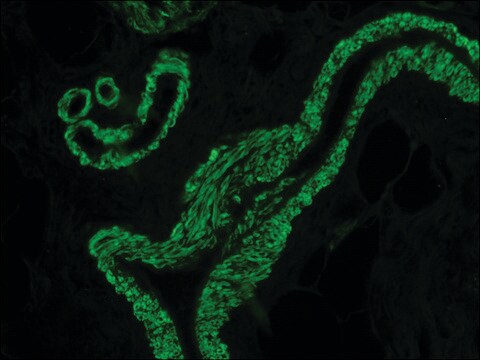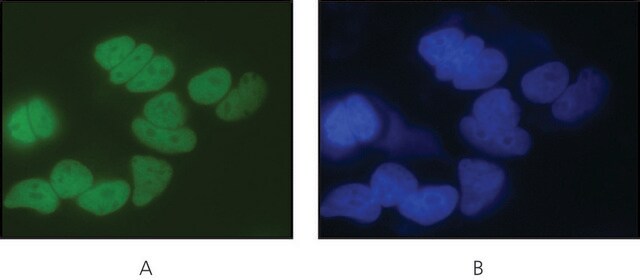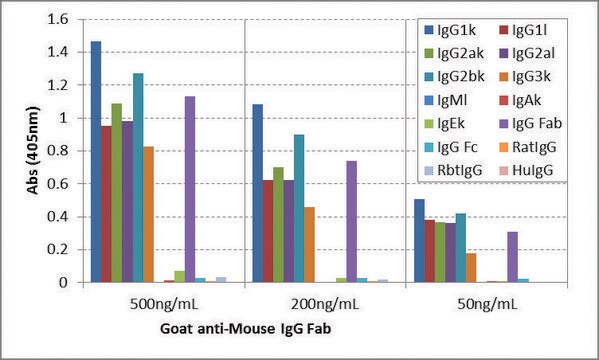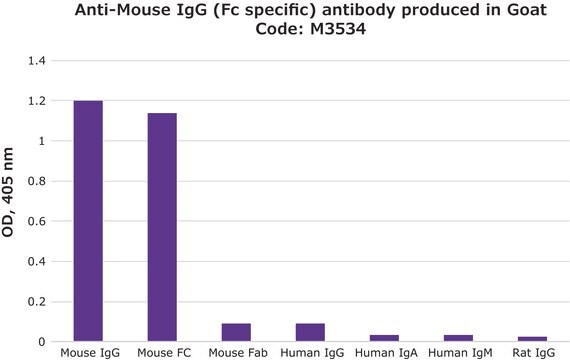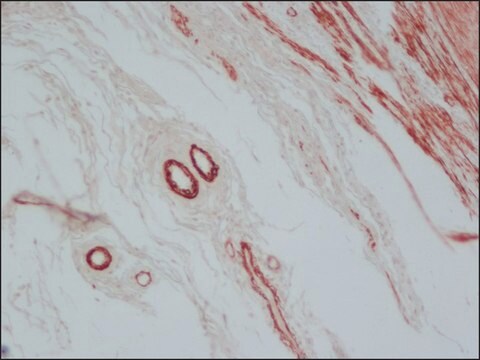Wszystkie zdjęcia(1)
Kluczowe dokumenty
M0659
Anti-Mouse IgG (Fab specific) F(ab′)2 fragment antibody produced in goat
affinity isolated antibody
Synonim(y):
Fragment Fab anty-Mouse, Kozia anty-Mysia IgG Fab, Wykrywanie specyficzne dla Fab
Zaloguj sięWyświetlanie cen organizacyjnych i kontraktowych
About This Item
Polecane produkty
pochodzenie biologiczne
goat
białko sprzężone
unconjugated
forma przeciwciała
affinity isolated antibody
rodzaj przeciwciała
secondary antibodies
klon
polyclonal
stężenie
2.0 mg/mL
metody
indirect ELISA: suitable
Warunki transportu
dry ice
temp. przechowywania
−20°C
docelowa modyfikacja potranslacyjna
unmodified
Opis ogólny
Immunoglobulin G (IgG) is a glycoprotein antibody that regulates immune responses such as phagocytosis and is also involved in the development of autoimmune diseases . Mouse IgGs have four distinct isotypes, namely, IgG1, IgG2a, IgG2b, and IgG3. IgG1 regulates complement fixation in mice
Anti-Mouse IgG (Fab specific) F(ab′)2 fragment antibody is monospecific as determined by immunoelectrophoresis versus normal mouse serum, mouse IgG and the Fab fragment of mouse IgG. The antibody does not react with the Fc fragment of mouse IgG. Moreover, no reactivity is observed with human κ or lambda light chain, IgG, IgA, IgM, IgD and IgE, bovine IgG and IgM, or horse IgG as determined by ELISA. In immunoelectrophoresis, the antibody preparation is found to consist only of the F(ab′)2 fragment of goat IgG, where specific antisera is applied to goat IgG fragments. No contamination with goat IgG whole molecule is observed.
Anti-Mouse IgG (Fab specific) F(ab′)2 fragment antibody is monospecific as determined by immunoelectrophoresis versus normal mouse serum, mouse IgG and the Fab fragment of mouse IgG. The antibody does not react with the Fc fragment of mouse IgG. Moreover, no reactivity is observed with human κ or lambda light chain, IgG, IgA, IgM, IgD and IgE, bovine IgG and IgM, or horse IgG as determined by ELISA. In immunoelectrophoresis, the antibody preparation is found to consist only of the F(ab′)2 fragment of goat IgG, where specific antisera is applied to goat IgG fragments. No contamination with goat IgG whole molecule is observed.
Immunogen
Mouse IgG
Zastosowanie
Anti-Mouse IgG (Fab specific) F(ab′)2 fragment antibody is suitable for use in ELISA (using a conc. Of 2μg/mI (100 μg/well) in 50 mM carbonate/bicarbonate buffer, at pH9.6) . The antibody can also be used in immunoelectrophoresis.
Inne uwagi
Antibody adsorbed with bovine, equine and human serum proteins.
Postać fizyczna
Solution in 0.01 M phosphate buffered saline, pH 7.4, containing 15 mM sodium azide.
Oświadczenie o zrzeczeniu się odpowiedzialności
Unless otherwise stated in our catalog or other company documentation accompanying the product(s), our products are intended for research use only and are not to be used for any other purpose, which includes but is not limited to, unauthorized commercial uses, in vitro diagnostic uses, ex vivo or in vivo therapeutic uses or any type of consumption or application to humans or animals.
Ta strona może zawierać tekst przetłumaczony maszynowo.
Nie możesz znaleźć właściwego produktu?
Wypróbuj nasz Narzędzie selektora produktów.
Kod klasy składowania
12 - Non Combustible Liquids
Klasa zagrożenia wodnego (WGK)
nwg
Temperatura zapłonu (°F)
Not applicable
Temperatura zapłonu (°C)
Not applicable
Wybierz jedną z najnowszych wersji:
Masz już ten produkt?
Dokumenty związane z niedawno zakupionymi produktami zostały zamieszczone w Bibliotece dokumentów.
Klienci oglądali również te produkty
T E Steinsvik et al.
Scandinavian journal of immunology, 42(6), 607-616 (1995-12-01)
SCID and RAG-2 deficient mice were transplanted intraperitoneally with human peripheral blood lymphocytes (hu-PBL-SCID and hu-PBL-RAG mice). Seven days after transplantation the mice were immunized with a pneumococcal polysaccharide vaccine. Flow cytometry analysis of cells from the peritoneal cavity and
The Ocular Conjunctiva as a Mucosal Immunization Route: A Profile of the Immune Response to the Model Antigen Tetanus Toxoid
Barisani-Asenbauer T, et al.
PLoS ONE, 8(4) (2013)
Peter Engelhardt et al.
Methods in molecular biology (Clifton, N.J.), 369, 387-405 (2007-07-28)
Standard immunogold-labeling methods in transmission electron microscopy (TEM) are unable to locate immunogold particles in the depth direction. This inability does not only concern bulky whole mounts, but also sections. A partial solution to the problem is stereo inspection. However
J Wang et al.
Journal of neuroscience research, 50(1), 23-31 (1997-10-23)
The role of the transcription factor AP-1 in regulating D2 receptor transcriptional activity was investigated in D2 receptor expressing neuroblastoma cells, NB41A3, and in non-D2 receptor expressing CHO cells. Deletion of a region containing the putative AP-1 binding site resulted
Chen Yang et al.
Molecular medicine reports, 18(2), 1353-1360 (2018-06-15)
Previous studies have demonstrated that lipid rafts and β‑adducin serve an important role in leukocyte rolling. In the present study the migratory ability and behavior of neutrophils was demonstrated to rely on the integrity of the lipid raft structure. β‑adducin
Nasz zespół naukowców ma doświadczenie we wszystkich obszarach badań, w tym w naukach przyrodniczych, materiałoznawstwie, syntezie chemicznej, chromatografii, analityce i wielu innych dziedzinach.
Skontaktuj się z zespołem ds. pomocy technicznej


